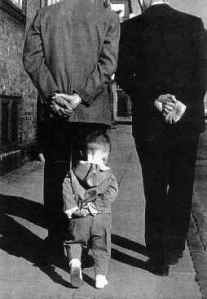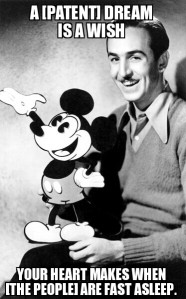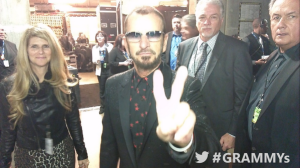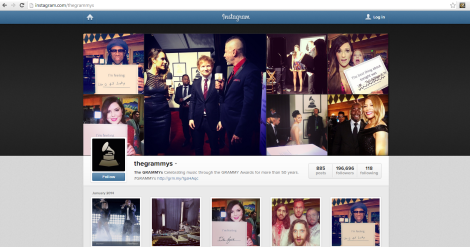What was I thinking?!?
Once upon a time there was a man with an idea. He got this idea like anyone else has their ideas, from another idea! He was thinking of the stories his mother would tell him every night as a boy before he slept. He had the idea to make the stories last beyond his mother’s words. He would love how she would whimsically describe the magical creatures and far off lands, so he decided to draw these stories to life in his own way. Sure, it had been done before, but this man had known Socrates’ idea in that “we cannot live better than in seeking to become better.” This man’s idea seeking to express his nostalgia for his childhood stories turned into a lifetime career of making old childhood stories better through visual images of his own interpretations! No harm no foul…right? “Copying and imitation are central to our process of learning and the acquisition of skills (pg 2 Drahos & Braithwaite). Remixing is apart of the fabric in human nature.

Learning.
Back to our boy, unless it’s before the 1980’s this man can live his happily ever after. Any time after 1988, this man lives in the land of Intellectual Property Rights which is a realm that has been allowed to reign darkness over the bright possibilities in free, open, and shared space for knowledge, discovery & creations. ‘Happily ever after’ is not my personal perception of utopia or an unrealistic place where there are no laws protecting innovation. However, do we even want a happily ever after where everything is free and there are no limits? Do we know what this looks like within a balance of appropriate Intellectual Property Rights? Is the correct question; do we know how to get back to the path towards a happily ever after? But even the scariest question pondered; has our perception of happily ever after been sliced and diced into rationed portions and assigned to the privileged to be trickled down into our societal feudalistic plots?
I was born in 1984. I had no idea where the US legislation was taking our country. I’m surprised to learn about the beginnings of what I thought was a media institution protected by the First Amendment and not strangled by perceived defenses cultivated in the idea of a patent. Could this man whom I idolized with my solo ballads in my living room singing along to retold childhood fairytales be responsible for the barrier of dreams? A “patent functions as a barrier to entry to the market,” therefore not allowing for competition (pg3 Drahos & Braithwaite).

What’s your dream?
I believe in the people’s choice. I believe in the people’s decision. I believe in popular sovereignty. I’m thinking that this dream of Disney’s was never to share in decisions with the voice of the people, but to protect a monetary structure gain to a point of privileged absurdity.
While watching Remix: a manifesto I couldn’t help but get angry because all of the points where I knew someone needed to say, “hey, this is wrong.” Yet through all of the legislation that was passed, the voice of the people became muted compared to the volume of the lobbyist actions from the corporate power houses.

Media Companies Consolidation
In a climate of “angry protectionism” changes were allowed to be made with “tough talk and the desire for action (85 Drahos & Braithwaite).” Countries signed into trade agreements and treaties pertaining to intellectual property without reading the fine print.
There are not too many things that were done that could be louder in action than the corporate conglomerate’s influence in all aspects of government from committees to lobbyist. “The simple message, which was repeated again and again on Capitol Hill, was that American commerce was a commerce of ideas and creativity in desperate need of protection from thievery (pg89 Drahos & Braithwaite).” Building worldwide steam within the idea of intellectual property, the late 70’s and early 80’s gave way to the spreading of Intellectual laws, sanctions, and treaties far and wide. Citizens everywhere were being set up to play the role of pirate or underdog without notable diplomatic representation for those cast positions.
Many countries fell into the war on piracy with their intellectual rights and had many struggles, even with warning. It’s as if the people were the three little pigs and the big bad wolf tells you exactly what he is going to do. The American government, during this dark reign of power, took advantage of the ignorance of people and governments around the world. Furthermore, there are continued talks on lengthening the time on patents even more which will inevitably “blow houses down,” figuratively speaking. The houses could represent the intellectual thought and where it is created. When these figurative houses are not secured with a solid structure of protection, they are (and were) easy to take advantage of in a new system of trade and idea protection.

Hear no…, See no…, Speak no…
After destruction, one must look at the situation and say “I need to come up with a better way of doing this.” Drahos and Braithwaite gave great detail to the mountain of barriers that have been reinforced legislatively with money, time and intimidation. The countries that were able to sail the open pirate seas have a different perspective on the input to the use of public good. Remix: A Manifesto covered Brazil’s sharing culture and the positives that are able to be nurtured in contrast to it’s violent history. Brazil is not the solution for America. However, looking at how Brazil did not fall into the abyss of intellectual rights barriers, in which our government is continuing to fall into, it is clear to been seen, perhaps, how we could have done it better.
When the war against ideas is over, hopefully won by the people, I feel that Intellectual Property war crimes should be tried for the impediments of ideas in which could have comforted and saved the lives of numerous people worldwide. Who is responsible for this idea of real lives lost? For all the experiments unpursued, the possibilities in cures, and the citizens who could have valued the opportunity; the cost of idea protection does not pay for the loss in the greater good of human life. Laws must be questioned and be held accountable to the individuals who created them. Furthermore, representatives must be held accountable by the people, for the people. The government should not get its power from lobbyist or corporations. Our government was framed to receive its power from the people and by the people. Perhaps this is my skewed perception of my own ‘happily ever after.’ My magical power in this fairytale will be dialog through emerging media. Social media could be utilized as a resource to the people to solve the ignorance, accountability and put us on a different path. I’m just not sure about the road map there. Perhaps the right path is embedded within the patented dreams of Disney?
“Just because I cannot see it, doesn’t mean I can’t believe it.”-A Nightmare Before Christmas
“The past can hurt. You can either run from it or learn from it.”-The Lion King
“A lie keeps growing and going until it’s as plain as the nose on your face.”-Pinocchio
“Sometimes the right path is not the easiest one.”-Pocahontas
“Even miracles take a little time.”-Cinderella
“Giving up is for rookies.”-Hercules
“A single grain of rice can tip the scale. One man may be the difference between victory and defeat.”-Mulan
“All it takes is Faith and Trust.”-Peter Pan
“The way to get started is to quit talking and begin doing.”-Walt Disney
POST SCRIPT- Embedded within my own aesthetics is Disney. I struggled with this thought because of the shallowness I felt it projected surrounded by ATEC geniuses. Please enjoy the video defining my personal aesthetic.
Works
Drahos, P. and Braithwaite, J. Information Feudalism. UK: Earthscan Publications Ltd, 2002. Print.
Pictures
http://creativethinking.net/articles/2011/08/29/walt-disney%E2%80%99s-creative-thinking-technique/
http://www.businessinsider.com/these-6-corporations-control-90-of-the-media-in-america-2012-6
http://mikephilbin.blogspot.com/2012_06_01_archive.html
http://www.inspirational-quotes-change-lives.com/disneymoviequotes.html
http://www.inscribd.com/32-disney-movie-quotes-of-encouragement/#axzz2wUyDouUh
Question for the general youth of today, “who here knows Pink Floyd?” All bets are on a ‘Bueller’ response.
Another Brick in the Wall by Pink Floyd, written by Rogers Waters, personifies the same entitled mantra that our present youth symbolize through the everyday use of their layered media activities.
The difference with the present youth today, besides fashion and slang, is the presence of the ever-growing utilization of technology in their daily lives. “The layering of media and social interaction is part of a changing media ecology that youth inhabit…” (Horst, Herr- Stephenson & Robinson, 2010). Today’s young individual ranging from 13-18 years old can be attending class in school, texting parents for permission to ride home with friends, and sending homework via email all in a matter of moments, if not all together at once.
Another brick in the Wall lyrics, “we don’t need no education, we don’t need no thought control” represent negotiations between youth and their need to exercise and “develop their social and cultural identities in ways that are independent from their parents, and [today] they are aided now in these practices by a new suite of communication tools” (Boyd, 2010). Youth must be guided, just as in every previous generation, to define their space, declare their independence, and become well-balanced adults. Youth desire to be able to do whatever it is that they are interested in at that moment. Whether it be labeled by Mizuko as “Hanging Out, Messing Around and Geeking Out,” embedded are the same social behaviors that every youth generation has experienced since the 1920’s. The context and mediums have changed, but “the core practices of how youth engage with media as part of their hanging out with peers remains resilient” (Horst, Herr- Stephenson & Robinson, 2010). New media serves the same old youth motives of friendship, intimacy, and personal discovery.
Youth today are not only connecting to a networked social realm, they are using “a variety of social media to develop and maintain broader communities of peers” (Boyd, 2010). Through this navigation of new media our present day youth have a different opportunity than any other generations before. The youth today have an instant connection to information, skills, and interactions that are waiting to be revealed. Only about 1% of youth today have not experienced an online interaction (Horst, Herr- Stephenson & Robinson, 2010). What many individuals, adult and youth, do not really comprehend is the internet’s ability to capsulate and preserve information even with a perceived deletion. Digital literacy within new media is an obvious necessity to our youth’s development into well-rounded prosperous adults.
Youth must be guided through digital literacy, just like any other learned skill. It is suggested by Horst, Herr- Stephenson & Robinson, “that learning and participation with new media needs to be contextualized within a broader social-, culture-, technical-, and place-based ecology”. School districts must get creative within their professional development to foster and embed digital literacy into classroom curriculum. “While standards for literacy are constantly under negotiation in any community of practice, we do believe the relative newness of digital production and online communication means that we are in a moment of interpretive flexibility, where values, norms and literacy are particularly malleable” (Ito, 2010).
However, this is not what I experienced in my past teaching career. Sure, there are districts that receive grant monies and budget to purchase all the students IPads and more technology in the classrooms! That is good and great, but what I experienced as a middle and high school teacher was that the teachers were not being equipped to implement such new media. With my six years in education, I cannot tell you how many teachers I heard say “I’m not doing that in my classroom” when we would have ‘specialists’ demonstrate different platforms and mediums we were expected to implement. There was more of an attitude of being overwhelmed considering the transition into new media that most teachers had not encompassed in their own digital literacy. While teachers slowly shift their attitudes “…youth continue to test the limits on forms of new media literacy and expression” (Ito, 2010).
Many teachers find themselves being the student while another more digitally literate teacher or even a student becomes their “techne-mentor.” Teachers are expected to fluidly put down their (sometimes ancient) curriculum habits, paper and pencil ways to incorporate a new media implementation to present their curriculum. Explaining Media Ecologies, Horst, Herr-Stephenson & Robinson describe the use of the term “techne-mentor” as someone who takes on the teaching aspect with unfamiliar media. A techne-mentor essentially gives advice and tips on the new media in topic. Moreover, a tutorial.
My first year teaching, I remember drooling when a teacher down the hall had a fully loaded Promethean Interactive Smart Board installed in her classroom. It had its own stereo system and touchable interface! I got her to let me come in during my off period to play with it to show her all the features I had learned and other media that could be collaborated within the smart board. I became a big part in educating educators on the new resources in new media we had come available to us during my teaching career because I have always been interest driven within my own digital literacy. I was able to have my students buy in to my history curriculum by tapping into their new media usage in consideration to my own.
Classroom and home life media ecologies must become more digitally literate. Horst, Herr-Stephenson & Robinson quote Wenger to explain, “…communities of practice approach to learning posits that the development of knowledge and expertise is deeply integrated with being part of social groups engaged in joint activity.” Students must have the opportunities to navigate and negotiate as many new media opportunities as possible to develop diverse critical skills beyond teacher-driven lessons. With reflection to Pink Floyd’s Another
Brick in the Wall, “we do not believe that educators and parents need to bear down on kids with complicated rules and restrictions and heavy-handed norms about how they should engage online” (Ito, 2010). Digital literacy, especially within new media, is paramount for the future success of our youth and must become an active conscience priority in schools and homes.
Teachers do not need to leave students alone! Youth do need education! They do not need thought control. Adults must embrace digital literacy
strategies equipping students to navigate the diverse media ecologies. “Given the prominence of social media both contemporary teen and adult life, learning how to manage the unique affordances of networked sociality can help teens navigate future collegiate and professional spheres where mediated interactions are assumed” (Boyd, 2010). Digital literacy must become a respected embedded dialogue into the culture of the classroom and home lives of youth to foster future successful management of various new media spaces.
Horst, H., Herr- Stephenson, B., & Robinson, L. (2010). Hanging out, messing around, and geeking out: Kids living and learning with new media; Media Ecologies. (p. 50, p.40, p. 33, p. 76, p. 59 p.36 ).
Boyd, D. (2010). Hanging out, messing around, and geeking out: Kids living and learning with new media; Friendship. (p. 114, p. 79, p. 113).
Ito, M. (2010). Hanging out, messing around, and geeking out: Kids living and learning with new media; Conclusion. (p. 342, p 341, p 342).
If the 2014 GRAMMYs were a 56 year old lady standing beside me in Starbucks, I’d by her a drink because she was one bad mamma jamma!
 Throughout the enveloping experience watching this years GRAMMYs, the audience was able to listen to the hottest songs from the radio, watch the glimmer and glamour of all of Hollywood’s finest actors & musicians
Throughout the enveloping experience watching this years GRAMMYs, the audience was able to listen to the hottest songs from the radio, watch the glimmer and glamour of all of Hollywood’s finest actors & musicians , and read up to the second contributions on Facebook, Twitter, Pinterest, and Instagram. Beyond the crazy hats making statements & musically collaborative moments that must to have been dreamed up, there was an aura of hashtag in the televised atmosphere. On a new scale of self-awareness, Social Media collaboration during the 2014 GRAMMYs conjured instant sharing while cultivating expectations of future involvement for television network productions. The Grammy’s opened its curtains for participants to engage with combination mediums intertwining radio, television, and social media. This opportunity has allowed people a choice in mediums with content that brings music to many ears.
, and read up to the second contributions on Facebook, Twitter, Pinterest, and Instagram. Beyond the crazy hats making statements & musically collaborative moments that must to have been dreamed up, there was an aura of hashtag in the televised atmosphere. On a new scale of self-awareness, Social Media collaboration during the 2014 GRAMMYs conjured instant sharing while cultivating expectations of future involvement for television network productions. The Grammy’s opened its curtains for participants to engage with combination mediums intertwining radio, television, and social media. This opportunity has allowed people a choice in mediums with content that brings music to many ears.
CBS produced and successfully executed The 56th GRAMMYs by baiting their many different lines of communication to get and “trap attention.”  ‘Understanding Media’ by Marshall McLuhan is utterly relevant to the evolution of how individuals are engaging with their television and social media today. McLuhan is well-known for his views about “the medium is the message. This is merely to say that the personal and social consequences of any medium – that is, of any extension of ourselves – result from the new scale that is introduced into our affairs by each extension of ourselves, or by any new technology” (pg 1).
‘Understanding Media’ by Marshall McLuhan is utterly relevant to the evolution of how individuals are engaging with their television and social media today. McLuhan is well-known for his views about “the medium is the message. This is merely to say that the personal and social consequences of any medium – that is, of any extension of ourselves – result from the new scale that is introduced into our affairs by each extension of ourselves, or by any new technology” (pg 1).
The 2014 GRAMMYs content was amplified with its own structural set up of a twitter camera back stage along with a Social Media covering blanket of retweets and hashtags screaming for future productions to take note. Cough cough…OSCARS! From celebrity’s to the common fan, all could input &/or lurk real time with the #GRAMMYs alongside of other self-aware trends.
Never before has an audience been so large in contributing and expecting instant interaction. Twitter reports that there were 15.2 million tweets about the GRAMMY’s during the nearly 4 hour broadcast. The performance by Imagine Dragons and Kendrick Lamar recorded 171,593 tweets per minute!
 The GRAMMYs performed everything over the top. Moments including a wedding of 33 gay and straight couples getting married by Queen Latifah, immediately sung to by Madonna, on top of countless collaborations between the legendary talented & newly well-known musicians were all being catapulted into the lives of the viewers beyond the television. McLuhan speaks about “the effect of the medium is made strong and intense just because it is given another medium as ‘content’ (pg6). Further growth of similar expectations are currently being embedded into other content expectations, therefore strengthening the message within the Grammy’s mediums. This expectation of instant interaction will grow among partakers of the mediums no matter what the content. After watching the YouTube lecture “The Medium is the Message,”
The GRAMMYs performed everything over the top. Moments including a wedding of 33 gay and straight couples getting married by Queen Latifah, immediately sung to by Madonna, on top of countless collaborations between the legendary talented & newly well-known musicians were all being catapulted into the lives of the viewers beyond the television. McLuhan speaks about “the effect of the medium is made strong and intense just because it is given another medium as ‘content’ (pg6). Further growth of similar expectations are currently being embedded into other content expectations, therefore strengthening the message within the Grammy’s mediums. This expectation of instant interaction will grow among partakers of the mediums no matter what the content. After watching the YouTube lecture “The Medium is the Message,”
I feel that McLuhan would have a comical stark comment on the “mass man” idea with Social Media serving up the consequences of our nature within self-awareness.
No matter what awareness you might have at this moment, please be aware that the 2014 56th GRAMMYs #blewmymind. #Thankyou #CBS #WhatWhouldMcLuhanSay
Looking back, my whole life seems so surreal. I didn't just turn up on the doorstep playing rugby; I had to go through a whole lot of things to get there. -Jonah Lomu
6300 EMAC Lane